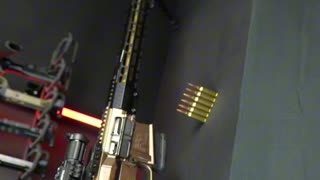Premium Only Content

Zero your scope. Just the basics
In this video, the creator explains the basics of zeroing a scope, which is an essential skill for ensuring that your rifle's optic is properly aligned with your point of impact. The video provides a step-by-step guide to help both beginners and experienced shooters understand how to adjust their scope’s elevation and windage turrets to achieve an accurate zero. Here's an overview of the key points:
Key Points Covered:
Basic Zeroing Concepts:
Elevation (up and down) and Windage (left and right) adjustments are controlled via the turrets on the scope.
The creator explains how to move the point of impact (where the bullet hits) rather than adjusting the reticle (crosshairs) itself.
Adjustments are made based on your shots; for example, if your point of impact is low and right of your target, you would adjust the elevation and windage to move the point of impact up and to the left.
Shooting and Adjusting:
After taking your first shot and assessing where the bullet landed, you make the appropriate adjustments to bring your point of impact closer to the center of the target.
The creator suggests taking multiple shots to fine-tune the zero and ensure consistency before making final adjustments.
Bore Sighting:
If you do a bore sighting, the process is the opposite of adjusting for impact. When using bore sighting, the reticle is adjusted to match the barrel's point of aim, rather than moving the point of impact to match the crosshairs.
The creator walks through the process of how to line up the barrel with a target and adjust the reticle to match it.
Setting Your Zero:
Once you're zeroed in at a distance (typically 100 yards), you can set your turrets back to zero. For scopes with locking mechanisms, the creator demonstrates how to ensure that the turret stays locked in place at the correct zero, preventing accidental adjustments.
Data on Previous Engagements (DOPE):
The creator briefly touches on DOPE (Data on Previous Engagements), which is used to track your rifle’s performance at various ranges. This data helps you know how much to adjust your scope at different distances (e.g., how much the bullet drops at 200 yards).
Turret Locking Mechanisms:
For scopes with locking turrets, like the Trinity Force scope or the Arin LH4, the video demonstrates how to properly lock and unlock the turrets after zeroing to ensure your settings are saved and not accidentally changed during shooting.
Additional Notes:
The video focuses on basic zeroing and doesn’t dive too deep into advanced optics terminology like MOA or Mil-Dots but explains how different types of scopes and turrets work.
The 100-yard zero is the standard for many shooters, though the creator acknowledges that different distances might work better for different calibers or purposes.
Conclusion:
By following the steps outlined in the video, you’ll be able to confidently zero your scope, ensuring that your rifle is shooting precisely where you're aiming. Proper zeroing makes it easier to adjust for longer distances and different shooting conditions, improving overall shooting accuracy.
This video is an excellent resource for those new to shooting and scope adjustments, providing practical guidance on how to get your rifle setup for success with minimal confusion.
Get smarter responses, upload files and images, and more.
Log in
Sign up
-
 0:59
0:59
Tactical Weapon Combat Ready
12 days agoDNT ZULUS 5-20X Digital Night Vision Scope| Budget Night Vision, This Changes EVERYTHING!
1171 -
 LIVE
LIVE
Benny Johnson
1 hour agoLIVE Trump Cabinet Meeting Right Now in White House, Trump Torching Media | Michelle Obama MELTDOWN
8,438 watching -
 LIVE
LIVE
The Shannon Joy Show
1 hour ago🔥🔥100 Day SHOCKER - Trump Is Deporting FEWER Illegal Immigrants Than Biden! He’s Also Pimping Biden’s mRNA & Fast Tracking Self-Amplifying mRNA Shots! With Special Guests John Beaudoin Sr. & Jessica Rose🔥🔥
118 watching -
 LIVE
LIVE
Right Side Broadcasting Network
3 hours agoLIVE: President Trump Holds a Cabinet Meeting - 4/30/25
5,623 watching -
 LIVE
LIVE
BitLab Academy
2 hours agoCrypto DIP ALERT! Bitcoin & Atcoins: Sell In May? Crypto Pump or Dump Next!?
113 watching -

Dr David Jockers
1 hour agoHow Sourdough Bread Impacts Blood Sugar and Gut Health!
26 -
 1:00:37
1:00:37
VINCE
3 hours agoMedia Lies On Trump's 100 Days | Episode 33 - 04/30/25
150K95 -
 DVR
DVR
Badlands Media
9 hours agoBadlands Daily: April 30, 2025
27.8K6 -
 2:59:33
2:59:33
Wendy Bell Radio
7 hours agoIt's The Trump Show
58K45 -
 LIVE
LIVE
Bannons War Room
2 months agoWarRoom Live
7,704 watching